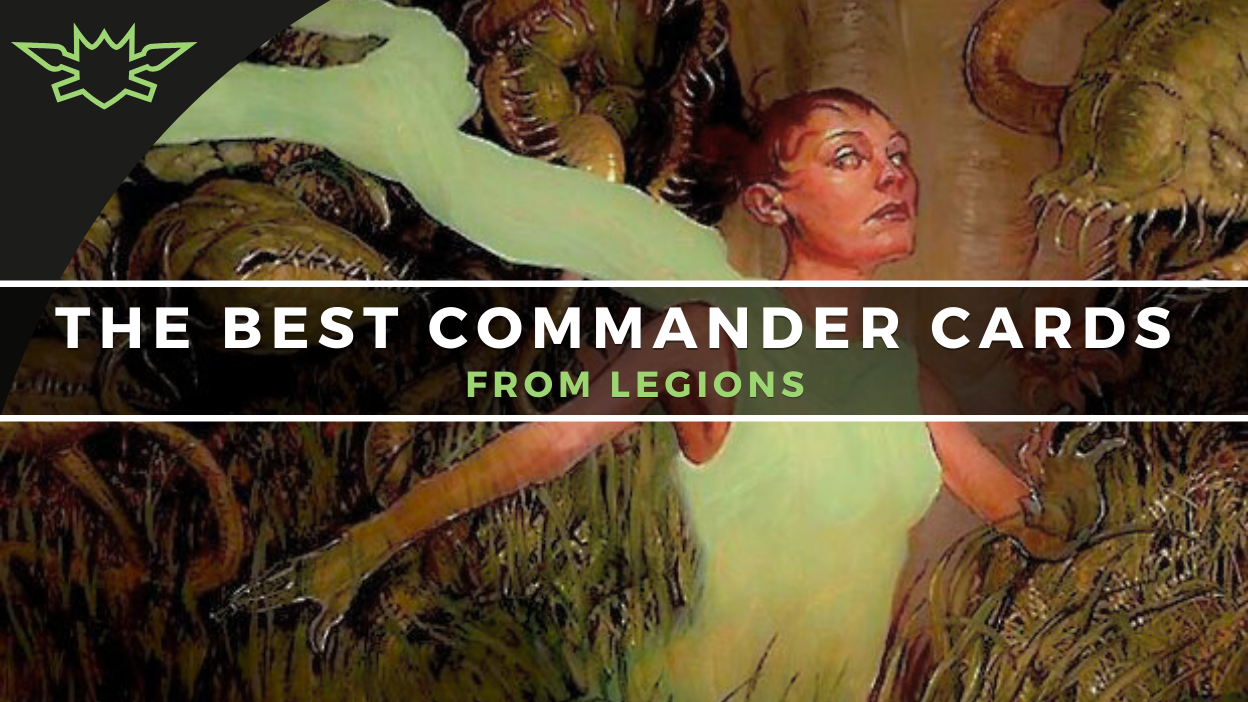The Best Commander Cards From... Legions

Welcome back to The Best Commander Cards From..., a series looking at the most powerful Commander cards from across Magic: The Gathering's rich thirty-year-long history. Today's focus is Legions, the twenty-eighth expansion set, which was released in February of 2003 and is the second set in the Onslaught block.
Legions Lore
As you can imagine, Legions picks up where Onslaught left off. This set gets a bit weird, and even weirder if you read the book. In fact, most of the key events in this story aren't even featured on cards, so if you didn't read that book, you're going to miss a lot of details.
What kind of details? Well, Kamahl spends a decent portion of the story just meditating while the actual plot is happening. Don't worry, though: he shows up at the end and accidentally creates a literal goddess by killing three people, one of whom was literally falling from the sky, in a single swing. Most of the plot, however, actually hinges around the ongoing war between Akroma and Phage.
Legions Mechanics
Morph, amplify, provoke, and even double strike found their way in, but the biggest thing you'll notice about this set is that creatures are the only card type featured in it! I think this was a terrible choice for a number of reasons, but this early in the Magic history I can appreciate the desire to experiment. With all that in mind, let's get into the cards themselves.
Akroma, Angel of Wrath
In spite of the high cost, protection from red and black are still fantastic abilities on a huge creature. The keyword soup Akroma has makes her perfect for Odric, Lunarch Marshal
Celestial Gatekeeper
Admittedly, Legions is a set where kindred themes are quite common, and we're gonna have to highlight some kindred payoffs. Celestial Gatekeeper
Essence Sliver
Oh, did I forget to mention that Slivers are in this set? They sure are! This psuedo-lifelink effect is an ability that you might undervalue until you're at 10 life facing down a card like Purphoros, God of the Forge
Glowrider
You can play Glowrider
Plated Sliver
The highlight of Plated Sliver
Ward Sliver
Suddenly getting protection from an entire color usually means you'll be able to take out at least one player at many tables, and that makes the five-mana pill that is Ward Sliver
Windborn Muse
The Muse cycle has some real heavy hitters, and Windborn Muse
Riptide Mangler
In a lot of games, I expect that Riptide Mangler
Shifting Sliver
Much like Ward Sliver
Synapse Sliver
It's feeling like a bit of a Sliver showcase, and that's because Slivers are one of the most popular creature types in the game, and because this set is full of them. Five mana is a pretty high cost, but considering how easy it is to give your Slivers evasion, Synapse Sliver
Willbender
Morph is the key here, as you're not getting the best deal out of a five-mana Redirect
Bane of the Living
Much like Willbender
Crypt Sliver
Two mana is the butter zone when it comes to Slivers. Crypt Sliver
Scion of Darkness
Of note, Scion of Darkness
Dark Supplicant
You can only really play Dark Supplicant
Graveborn Muse
On its own, Graveborn Muse
Phage the Untouchable
There's a lot of cheeky ways to sneak this into play under an opponent's control or safely play it to hit opponents, but I wouldn't recommend putting Phage the Untouchable
Gempalm Incinerator
If you're playing a lot of Goblins, Gempalm Incinerator
Hunter Sliver
Provoke is a pretty strong mechanic, and giving that to all your Slivers can spell doom for anyone with a valuable utility creature in play. Like a lot of the Slivers in this set, you will need power and toughness boosts to get the most out of Hunter Sliver
Magma Sliver
If you think the ability of Magma Sliver
Brood Sliver
Having your Slivers make more Slivers is pretty cool, and Brood Sliver
Caller of the Claw
I've always felt like Caller of the Claw
Quick Sliver
Flash grants an extra layer of lethality and surprise to your Sliver decks. Granting your team double strike, +1/+1, or regeneration can turn the tides of a game in an instant, and Quick Sliver
Seedborn Muse
The most widely played of the Muse cycle, Seedborn Muse
Timberwatch Elf
Elves are like Slivers in that you'll usually want a ton of them on the battlefield. Timberwatch Elf
Wirewood Channeler
Beyond making any color of mana, which is a decent upside, this basically functions as a bit of redundancy for other Elves, like Elvish Archdruid
Wirewood Hivemaster
While many kindred decks only care about getting a critical mass of one type of creature, you might like Wirewood Hivemaster
That's All, Folks!
Legions has a bad reputation for being a very peculiar set from a design perspective, and it's easy to see why. A creature-only set is a pretty big gamble. As a spellslinger, this set is pretty close to a nightmare for me to sift through, but there's also quite a bit to love, especially if you like Slivers! At any rate, I've been Luka Sharaska, and I hope you'll join me next time when I cover Scourge.